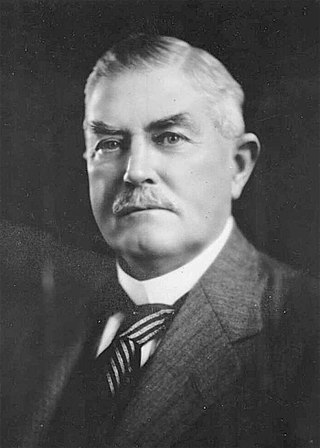Related Research Articles

Upper Hunter is an electoral district of the Legislative Assembly in the Australian state of New South Wales. The seat is currently held by Dave Layzell for the National Party after he was elected at a by-election to replace Michael Johnsen.

John Lionel Fegan was a politician and coal miner in New South Wales, Australia.
Singleton was an electoral district of the Legislative Assembly in the Australian colony of New South Wales created in 1894, existing from 1894 until 1913. It was named after the town of Singleton and replaced Patrick's Plains.
Members of the New South Wales Legislative Assembly who served in the 29th parliament held their seats from 1930 to 1932. They were elected at the 1930 state election, and at by-elections. The Nationalist Party was replaced by the United Australia Party in 1931. The Speaker was Frank Burke.

The 1932 New South Wales state election was held on 11 June 1932. This election was for all of the 90 seats in the 30th New South Wales Legislative Assembly and it was conducted in single member constituencies with compulsory preferential voting. It was a landslide victory for the UAP/Country Party coalition of Bertram Stevens, which had a majority of 42 in the Assembly.
Members of the New South Wales Legislative Assembly who served in the 25th parliament of New South Wales held their seats from 1920 to 1922. They were elected at the 1920 state election on 20 March 1920. The Speaker was Daniel Levy with the exception of 13–20 December 1921 when he was replaced by Simon Hickey.
Roger Bede Nott was an Australian politician and a member of the New South Wales Legislative Assembly from 1941 until 1961. He was a member of the Labor Party and held numerous ministerial positions between 1954 and 1961. He was the Administrator of the Northern Territory between 1961 and 1964.
Malcolm Brown was an Australian politician. He was a Country Party member of the New South Wales Legislative Assembly from 1931 to 1939, representing the electorate of Upper Hunter.
Alfred William Yeo was an Australian politician. He was a Country Party member of the New South Wales Legislative Assembly from 1932 to 1941, representing the electorate of Castlereagh.
Annandale, an electoral district of the Legislative Assembly in the Australian state of New South Wales, had two incarnations, the first from 1894 to 1920, the second from 1927 to 1950.
Clarence, an electoral district of the Legislative Assembly in the Australian state of New South Wales, has had two incarnations, the first from 1859 to 1920, the second from 1927 to the present.
Upper Hunter, an electoral district of the Legislative Assembly in the Australian state of New South Wales, has had three incarnations, the first from 1859 to 1894, the second from 1904 to 1920, and the third from 1927 to the present.

William George Ashford was an Australian politician.

Richard Thomas Ball was a politician and engineer in New South Wales, Australia.

The 1922 New South Wales state election was held on 25 March 1922. This election was for all of the 90 seats in the 26th New South Wales Legislative Assembly and it was conducted in multiple member constituencies using the Hare Clark single transferable vote. The 25th parliament of New South Wales was dissolved on 17 February 1922 by the Governor, Sir Walter Edward Davidson, on the advice of the Premier James Dooley.
Charles Hilton Dight was a member of the New South Wales Legislative Assembly.
Newtown, an electoral district of the Legislative Assembly in the Australian state of New South Wales, has had four incarnations, the first from 1859 to 1894, the second from 1904 until 1920, the third from 1927 until 1950 and the fourth from 2015 until the present.
Sturt, an electoral district of the Legislative Assembly in the Australian state of New South Wales, had two incarnations, from 1889 until 1968 and from 1971 until 1981.
The 1939 Upper Hunter state by-election was held on 7 October 1939 for the New South Wales Legislative Assembly electorate of Upper Hunter because of the death of Malcolm Brown (Country). There were three candidates endorsed by the Country Party.
The 1917 Macquarie state by-election was held for the New South Wales state electoral district of Macquarie on 28 July 1917. The by-election was triggered by the death of Australian Labor Party MP Thomas Thrower, who had died only three months after being re-elected at the 1917 state election.
References
- 1 2 "Mr William Cameron (1877–1931)". Former members of the Parliament of New South Wales . Retrieved 1 May 2019.
- ↑ "Upper Hunter seat". Singleton Argus . 22 May 1931. p. 8. Retrieved 25 November 2019– via Trove.
- ↑ "Upper Hunter: Country Party candidate". The Sydney Morning Herald . 13 June 1931. p. 14. Retrieved 25 November 2019– via Trove.
- ↑ "Advertising". Singleton Argus . 8 June 1931. p. 3. Retrieved 25 November 2019– via Trove.
- ↑ "Writ of election: Upper Hunter". New South Wales Government Gazette . No. 61. 18 May 1931. p. 1799. Retrieved 25 November 2019– via Trove.
- 1 2 Green, Antony. "1931 Upper Hunter by-election". New South Wales Election Results 1856-2007. Parliament of New South Wales . Retrieved 25 November 2019.
- ↑ Green, Antony. "1930 Upper Hunter". New South Wales Election Results 1856-2007. Parliament of New South Wales . Retrieved 3 May 2020.
- ↑ "Upper Hunter: Nationalist defeated, Brown gets Labor preferences". Western Champion . 22 June 1931. p. 3. Retrieved 25 November 2019– via Trove.